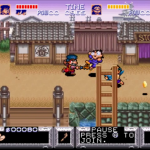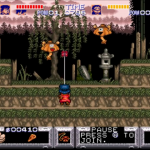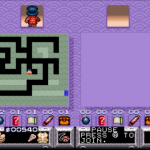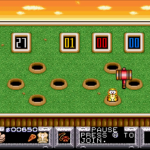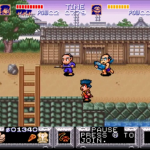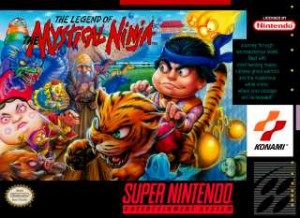
Author: merlinfunk
The first wave of Super Nintendo games to hit shelves held some giants whose gameplay, sound, and graphics raised the bar for all titles to follow. The Legend of the Mystical Ninja was just such a game: its 1992 release was the first of many confirmations for Nintendo’s disciples that they had faith in the right company.
It’s all about the story?
In Legend, we are introduced to the protagonists Kid Ying and Doctor Yang. Their adventure begins by investigating their town’s claims of ghosts from a nearby temple. From here, the two are led on a grand adventure all across a fictional Japan from towns, villages, temples, and even an amusement park. The culture portrayed in this game is a fascinatingly creative mix of feudal Japan’s characters, settings, clothing and weapons, with aspects of the 1990’s culture like televisions, stores, arcades, games, and even travel agencies. A strange mix, for sure, but an entertaining setting to take on a quest.
Controls and Gameplay
Legend of the Mystical Ninja is a RPG, platformer and 2-D beat-em-up rolled into one. It can be played as either character in single player mode, or two players can play simultaneously for increased insanity. The player uses one button to jump, and one to attack. There are a couple of neat options thrown into combat for variety. For one, the player can change their primary weapon (default using L or R buttons) to the game’s coin currency. This is a pretty fun option where coins can be tossed to damage enemies from a distance at the expense of your own funds. The coins are fairly powerful and effective on typical enemies, and also prove useful for some boss fights.
Second, the player’s primary weapon upgrades up to three times as they slay enemies. All 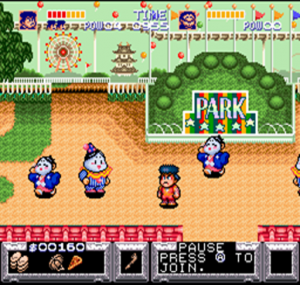 enemies drop an item when slain. Usually they drop coins, but sometimes it is a cat statue. These cats upgrade the main weapon from a short weapon (a pipe), to a longer one, to a different weapon (a spikey yo-yo) with even more reach.
enemies drop an item when slain. Usually they drop coins, but sometimes it is a cat statue. These cats upgrade the main weapon from a short weapon (a pipe), to a longer one, to a different weapon (a spikey yo-yo) with even more reach.
A third unique feature is to buy items from stores on some of the stage maps. These range from armor upgrades, to food that replenishes health, to very expensive Judo techniques. The Judo moves give the player special abilities when used such as riding an animal companion to flying.
There are three stage types in this game. One is a side-scrolling left to right platforming type of stage. Another is side-scrolling but also allowing movement up and down in something akin to a ¾ overhead view. The last type is a top down view of the action which plays almost like an old school shooter (think shooter with sticks instead of guns for weapons). All three stage types have their own charms.
The ¾ view allows the player to navigate on any path they can find through the stage. This opens up some options for how you travel through the game, though eventually you have to go a specific location to progress the story. It resembles a River City Ransom layout in this regard. To continue that similarity, in these stages you can find and enter shops. These add some fun options to the gameplay, but are not necessary for completing the game either. Shops allow you to upgrade your character’s armor and learn the powerful Judo techniques, as well as heal. This is the RPG element of the game. In one particularly fun level, you travel through a carnival. Through exploring you can find shops that allow you to play some fun mini-games like Breakout and even Gradius (isn’t it nice when your title is produced by Konami!). These ¾ stages allow the player to explore, upgrade (through stores), and find the entrance to the boss’s stage. One small feature to note is a timer running through these stages, which can be irritating if you are trying to explore or play mini-games. It’s not usually an irritating issue, but it does force you to move ahead and not linger and explore for long periods.
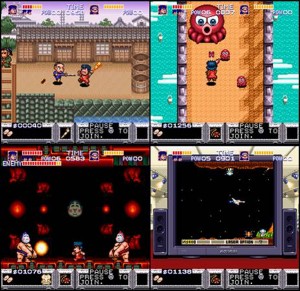 The side-scrolling stages in this game are usually connected to a stage boss. When people hear side-scrolling platforming they tend to think of the original greats like Mega Man or Mario. Although there are some tricky jumps, it does not play like any Mario titles. Jumping in this game can be fairly clunky at times, making this ability lack the fluidity of a solid Mario game. Legend’s side scrolling stages do bear some resemblance to a Mega Man title, but without the long range attacks and multiple weapons. What really shines in these levels is the developer’s creativity with what can be done in 2D. There are some situations where the characters must leap into the background of a stage setting, similar to the first level of Castlevania IV. One particularly notable stage has the characters actually leap on switches to flip the stage: the ceiling becomes the ground and vice versa. This allows the player to traverse previously inaccessible areas, and to note how complex the level design really is!
The side-scrolling stages in this game are usually connected to a stage boss. When people hear side-scrolling platforming they tend to think of the original greats like Mega Man or Mario. Although there are some tricky jumps, it does not play like any Mario titles. Jumping in this game can be fairly clunky at times, making this ability lack the fluidity of a solid Mario game. Legend’s side scrolling stages do bear some resemblance to a Mega Man title, but without the long range attacks and multiple weapons. What really shines in these levels is the developer’s creativity with what can be done in 2D. There are some situations where the characters must leap into the background of a stage setting, similar to the first level of Castlevania IV. One particularly notable stage has the characters actually leap on switches to flip the stage: the ceiling becomes the ground and vice versa. This allows the player to traverse previously inaccessible areas, and to note how complex the level design really is!
Graphics
The sprites in this game are fantastically colored and animated. There are minute details in their motion such as mouths opening and closing, hair fluttering, and very expressive facial expressions when attacking or getting hurt. Each character sprite is interesting to look at, and each has unique moving, attacking and damage expressions and postures.
Stage maps are somewhat bland by comparison, but they do suit the game’s setting well enough. Most stages seem to have a lot of brown and dark colored hues, though this would probably be reminiscent of a feudal Japan setting. The one exception to this is, again, the carnival level. Here there are more pastels invading your sight and breaking up the typically dark palette.
Sound
The music is this game is excellent. From the title screen’s thundering Taiko drums to the haunting Asian melodies strewn throughout each stage, Japan’s cultural influence on this soundtrack is significant and awesome.
There isn’t much sound in the game otherwise, except for the sound of weapons being used and smacking an enemy. Each of these effects suits the game’s atmosphere well and does not detract from the feel of the game.
Overall Impressions
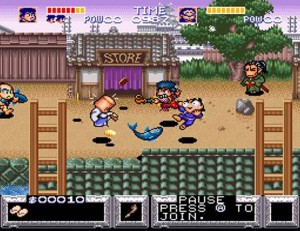 This game is a classic, first generation SNES title that set a high standard for all platformers and action games to follow. As such, it should be given reverence in any SNES library. It is impossible not to have fun while smacking a fishmonger with a spikey yo-yo in the pursuit of Judo techniques. I would recommend this to anyone who enjoys action, beat-em-up style games. It is decently challenging to complete, and will give any player hours of entertainment.
This game is a classic, first generation SNES title that set a high standard for all platformers and action games to follow. As such, it should be given reverence in any SNES library. It is impossible not to have fun while smacking a fishmonger with a spikey yo-yo in the pursuit of Judo techniques. I would recommend this to anyone who enjoys action, beat-em-up style games. It is decently challenging to complete, and will give any player hours of entertainment.
![]()
![]()
![]()
![]()
![]()
CLICK HERE TO COMMENT
HAVE AN OPINION?
You can submit reviews for games on the Submissions page.









